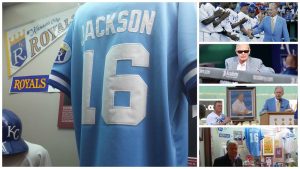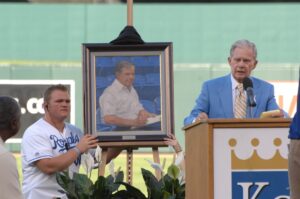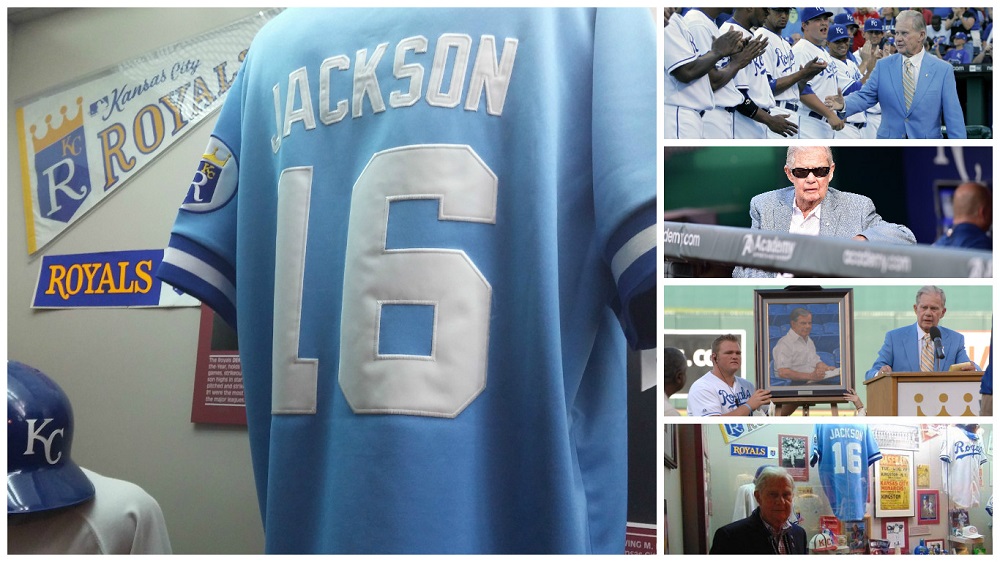
The old-time baseball scout who drafted Bo Jackson – and who has eyed every Kansas City Royals minor leaguer since the club’s inception in 1969, for that matter – has the stories, as you might imagine.
In fact, sit with and listen to Art Stewart and you can easily (and happily) lose a few hours of the day. After all, the man is pushing 90 and yet is still at it, continuing a career that began in the 1950s when he worked under the legendary scout who discovered the great Mickey Mantle on the Oklahoma prairie.
There’s the story of Stewart, sticking around a high school ballpark after other scouts bolted, only to find Jim Bouton, a future 21-game winner and key starting pitcher of two World Series teams. That’s one of his best stories, but perhaps not the best.
How fitting it was when Stewart, walking through the Missouri Sports Hall of Fame on the day of his induction this past January, broke into a huge grin. This upon spotting the large, glass-encased Royals display, which included a certain powder-blue jersey – the one stitched with No. 16, with the name “Jackson” emblazoned across the back shoulders. In essence, it represents Stewart’s favorite – and most heart-racing – scouting story, one that played out 30 years ago this summer.
“I remember what Buck O’Neil said when Bo worked out for us and hit a home run,” Stewart said, referring to the late Negro Leagues player who scouted for big-league clubs for decades. “He said, ‘I’ve heard that sound off the bat only three times in my life – once by Babe Ruth, once by Josh Gibson and once by Bo Jackson.”
Stewart shared this story during what’s become a Royal Blue celebration at the Missouri Sports Hall of Fame, which has expanded its appreciation for Kansas City – and the club’s resurgence, especially the 2015 World Series crown – a number of ways in the past year.
None other than Royals owner David Glass, Royals president Dan Glass and the World Series trophy turned out for the Hall’s 2016 Enshrinement Ceremonies presented by Killian Construction. Additionally, a ground-to-roof window welcoming visitors to the Hall is now covered in photos of the Royals’ inspiring October, and the club’s 2015 World Series highlight video plays on a wide-screen TV in the lobby.


And then there is Stewart, inducted in the Class of 2016 and having played a significant, influential role in the Royals’ resurgence of two American League pennants and their first World Series championship since 1985.
What a career it’s been – one connected strongly to Missouri, mostly with the Royals but also to a southwest Missouri farmer, Tom Greenwade, the legendary Yankees scout known as the man who found Mantle.
“I had two pretty good ones,” Stewart said of his mentors, Paul Krichell and Greenwade, who was posthumously inducted into the Missouri Sports Hall of Fame in 2013. Krichell, by the way, signed Lou Gehrig. “Greenwade said, ‘Keep your mouth closed and your eyes open.’ And he gave me the best piece of advice – never leave the ballpark early.”

Stewart’s journey through baseball led to one of the most memorable days in Royals history, in early June 1986. It was the day Kansas City drafted Jackson, considered the ultimate athlete of all athletes but yet a mysterious wild card, in baseball terms anyway.
Ultimately, the day also would say a lot about the importance of old-fashioned scouting, of driving down two-laners to find talent, of sending in reports late at night from cheap motels and of working in the shadows just to help a big-league club win ballgames.
At the time, Stewart had every reason to worry about his own immediate future. He had just been promoted to scouting director after 16 years of covering the Midwest territory in the Royals scouting department, so every high-level draft pick – high-level, considering the financial investment – would ultimately reflect on him.
And that morning, the agent representing the Royals phoned in to say that Jackson would sign with the Royals if they were to draft him. Immediately, the Royals had an unforeseen problem – do they let the first round pass and take their chances? Or they burn their No. 1 draft pick right off the bat? And if they do, would he even sign?
“If we don’t sign him,” Stewart recalled telling his scouts in the draft room that day, “we won’t be here next week.” In other words, pink slips.

Second thoughts were understandable. Jackson was college football’s 1985 Heisman Trophy winner and a first-round draft pick of the NFL’s Tampa Bay Buccaneers. But he also had spurned the Yankees and Angels – the Yankees after they drafted Jackson 50th overall in 1982, the Angels after they selected him in the 20th round in 1985. In fact, then-Yankees owner George Steinbrenner reportedly fired a scout over New York’s swing-and-miss.
Was the phone call a ruse? Was it a ploy? Jackson, you see, had made clear he didn’t want to play for the Buccaneers, whom he blamed for ending his collegiate baseball career abruptly because the owner flew Jackson to Tampa – at the time against NCAA baseball’s amateur rules.
And there Bo and his agent were, on the other end of the line with the Royals scouting director giving the green light.
“I told John,” Stewart said, referring to then-Royals general manager John Schuerholz, “they’ve got to be telling the truth.”
With that, Stewart trusted his gut – which is to say he trusted one of his area scouts.
What the rest of the baseball world might not have known was that, for years, the Royals scout who covered Alabama and other Southern states had gotten to know Jackson’s family, especially his mother.
Kenny Gonzales, the scout, often made it a point to stay in the hotel where Jackson’s mother worked, and the two built a trustworthy, scout-parent relationship.
Ultimately, Stewart trusted the work of his scout, selecting Jackson in the fourth round, with the 105th pick. “I told our guys in the room, if we draft Bo and we don’t sign him, the franchise won’t fold,” said Stewart, knowing well that a fourth-round draft pick wouldn’t command a signing bonus as financially large as that of a first-round selection. “But when it was announced, the draft room in New York was like a morgue.”
When Jackson was introduced back in Kansas City, his mother rushed up to Gonzales and gave him a big hug – in front of owner Ewing Kauffman.
“Mr. Kauffman turned to one of the other owners and said, ‘I guess that’s what it’s all about, isn’t it?’” Stewart said, grinning.
Stewart went on to serve as Royals scouting director for 14 years and drafted more than 70 big-leaguers for the Royals, including Kevin Appier, Mike Macfarlane, Brian McRae, Mike Sweeney, Johnny Damon and Carlos Beltran.

He then served as Special Senior Assistant to the General Manager for several years before the club named him Special Assistant to the GM – roles which allowed Stewart to offer advice as GM Dayton Moore built the Royals’ 2015 World Series championship.
Through summertime, you’ll find Stewart sitting behind home plate and armed with a radar gun and scout’s notepad. In Kansas City, he can be found after games dropping by to offer his notes to manager Ned Yost. Elsewhere, he drops in on minor leaguers down on the farm, or travels to evaluate a potential draft pick.
As former Royals slugger Mike Sweeney put it, “All the great Royals have been Royals because Art Stewart said, ‘Yes, let’s take a chance on him.’”
To hear Stewart talk about his journey is, well, like watching an old-timer thumb through an old scrapbook of newspaper clippings.
Stewart was raised in Chicago and, because he earned more money coaching semi-pro baseball, he turned down minor league contracts from former big-leaguers-turned-scouts in George Sisler and George Moriarty, once a teammate of Ty Cobb. “My dad died when I was 4,” Stewart said, “and my mom was doing everything to keep the house.”
Fortunately, his big break came soon. Because 28 of Stewart’s semi-pro players signed pro contracts, the New York Yankees hired him. He spent 17 seasons scoring for New York (1952-1968).
Among his first big discoveries was a 6-foot right-hander, found because Stewart struck around at a high school ballpark after a starting pitching prospect was scratched, leading 20 scouts to head elsewhere.
“I got to the parking lot and remembered what Tom Greenwade said, and turned around,” Stewart said. “All of a sudden, I heard this smack, smack, smack in the right field bullpen, and here’s this kid warming up.” It was Bouton, eventually a 21-game winner for the Yankees’ 1963 World Series team.
Eventually, Stewart challenged himself by joining the expansion Royals. In his first two years, he signed two players who helped Kansas City win its first AL West title in 1976, Tom Poquette and Tom Bruno.
In 2008, Stewart was inducted into the Royals Hall of Fame and the Professional Scouts Hall of Fame. He recently authored a book titled, “The Art of Scouting: Seven Decades of Chasing Hopes and Dreams in Major League Baseball.”
“It’s always been a great organization,” Stewart said of the Royals. “There were some lean years after Mr. Kauffman died, but I think it was capped off this year with the World Series.”
